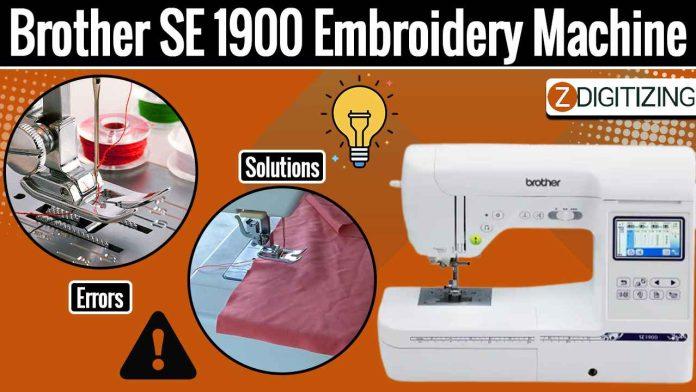Introduction
Embroidery enthusiasts and professionals alike often find themselves immersed in the world of intricate designs and colorful threads, creating stunning pieces of art on fabrics. The Brother SE 1900 embroidery machine is a popular choice in this realm, known for its versatility and capabilities. However, like any piece of machinery, the Brother SE 1900 is not immune to common problems that may arise during its usage. In this comprehensive guide, we will explore the typical issues faced by users of the Brother SE 1900 embroidery machine and provide practical solutions to troubleshoot them. Furthermore, we will delve into the realm of digitizing services for embroidery, highlighting the role of digitizing in achieving impeccable embroidery results.
Common Problems & Solutions
- Thread Breakage: One of the most frustrating issues that embroidery enthusiasts encounter is thread breakage. This issue can disrupt the embroidery process and lead to incomplete or imperfect designs.
Solution:
- Check the quality of the thread being used. Low-quality thread can easily break under tension.
- Ensure that the upper thread is threaded correctly through the machine’s various guides and tension disks.
- Examine the bobbin thread for any tangles or obstructions.
- Adjust the tension settings for both the upper and lower threads according to the manufacturer’s recommendations.
- Uneven Stitching: Uneven stitches can result in a messy and inconsistent embroidery design, affecting the overall visual appeal of the final product.
Solution:
- Verify that the fabric is properly hooped and stabilized to prevent shifting during embroidery.
- Calibrate the hoop to ensure it’s level and securely attached to the machine.
- Clean the machine’s feed dogs and bobbin area to prevent any lint or debris from affecting the stitching.
- Skipped Stitches: Skipped stitches create gaps in the design and can be caused by various factors.
Solution:
- Ensure the needle is correctly inserted and properly tightened.
- Use a new, high-quality needle appropriate for the fabric type.
- Check for any bent or damaged needles that need replacing.
- Slow down the embroidery speed, as high speeds can sometimes lead to skipped stitches.
- Design Alignment Issues: Incorrect design alignment can lead to overlapping or misplaced elements, ruining the intended design.
Solution:
- Utilize the machine’s alignment features to ensure accurate positioning of the design.
- Double-check the placement of the fabric in the hoop before beginning the embroidery process.
- Test the design on a scrap fabric before embroidering on the final piece.
- Bobbin Thread Showing on Top: When the bobbin thread shows on the top side of the fabric, it can compromise the design’s quality.
Solution:
- Recheck the bobbin threading to ensure it follows the correct path and is wound evenly.
- Adjust the tension settings to balance the upper and lower thread tension.
- Machine Jamming: Machine jamming occurs when the fabric gets caught or tangled within the machine.
Solution:
- Stop the machine immediately to prevent further damage.
- Gently remove the fabric and any tangles from the machine.
- Clean the machine’s interior regularly to prevent debris buildup.
Digitizing Services for Embroidery
Embroidery digitizing is a vital aspect of creating flawless embroidery designs. Digitizing involves converting an image or design into a format that an embroidery machine can understand and replicate accurately. This process requires a keen understanding of the embroidery machine’s capabilities and the intricacies of stitching techniques.
Why Opt for Digitizing Services:
- Professional Quality: Digitizing services ensure that your designs are translated seamlessly into embroidery, guaranteeing high-quality results.
- Complex Designs: Intricate designs with multiple colors and gradients can be challenging to digitize manually, making professional services invaluable.
- Time Efficiency: Digitizing requires expertise and time. By outsourcing this task, you can focus on other aspects of your embroidery projects.
- Optimized Stitching: Professional digitizers consider factors such as stitch density and direction to ensure that the final design is visually appealing and durable.
Finding the Right Digitizing Service:
- Experience: Look for digitizers with a track record of producing quality designs for a variety of fabrics and projects.
- Portfolio: Review their portfolio to gauge the quality and diversity of their work.
- Customer Reviews: Read reviews and testimonials from other clients to assess their satisfaction with the service.
- Communication: A good digitizer should be able to communicate effectively to understand your design needs.
Conclusion
The Brother SE 1900 embroidery machine is a remarkable tool for creating intricate and beautiful embroidery designs. By being aware of the common problems and their solutions, users can ensure smooth and successful embroidery projects. Additionally, the role of digitizing services in achieving top-notch embroidery results cannot be underestimated. With the right zdigitizing partner, you can transform your creative visions into stunning embroidered artworks, free from the technical hurdles that may arise. Embrace the world of embroidery with confidence, armed with the knowledge to overcome challenges and produce exceptional designs.
